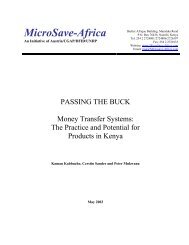Create successful ePaper yourself
Turn your PDF publications into a flip-book with our unique Google optimized e-Paper software.
People with guns, in<br />
canoes or otherwise,<br />
were somewhat<br />
common in <strong>DAI</strong> work<br />
areas, but by 2001,<br />
armed soldiers were<br />
protecting some <strong>of</strong><br />
<strong>DAI</strong>’s own <strong>of</strong>fices.<br />
80<br />
just across the border from Kuwait, and find a<br />
meeting place for the city’s town council. Bigger<br />
tasks soon followed in dealing with the looting<br />
that followed the fall <strong>of</strong> Baghdad. To help get<br />
the national ministries back on their feet, <strong>DAI</strong><br />
implemented a $4.1 million “ministry-in-a-box”<br />
program that provided standard <strong>of</strong>fice equipment<br />
to every agency <strong>of</strong> the Iraqi government.<br />
OTI’s effectiveness in those early weeks was<br />
noticed by the Coalition Provisional Authority,<br />
and soon the CPA and USAID quadrupled<br />
the budget. By its close in mid-2006, the Iraq<br />
Transition Initiative had disbursed some 5,000<br />
grants valued at more than $350 million across<br />
every province in the country. In contrast to the<br />
vast amounts wasted or stolen from many bigticket<br />
reconstruction contracts, ITI was efficient,<br />
lean, and gave value for money.<br />
From the beginning, security was a serious concern<br />
in Iraq. <strong>DAI</strong>’s ITI team was first stationed<br />
in Baghdad’s Green Zone, in one <strong>of</strong> Saddam<br />
Hussein’s palaces, communicating by satellite<br />
phone and using sleeping cots as desks. But<br />
staying in the safety <strong>of</strong> the Green Zone would<br />
compromise the team’s efficiency and ability<br />
to work with Iraqis. Within two weeks, employing<br />
the networks <strong>of</strong> an Iraqi firm <strong>DAI</strong> had been<br />
using in the northern, Kurdish city <strong>of</strong> Erbil, the<br />
<strong>DAI</strong> team moved into a safe area in the Mansoor<br />
District and began hiring Iraqi staff. Working<br />
through Iraqi firms based in Erbil but with nationwide<br />
and interethnic networks, ITI hired Iraqi<br />
guards, most <strong>of</strong> whom were peshmerga fighters<br />
from the north, to provide low-pr<strong>of</strong>ile but robust<br />
security. The presence <strong>of</strong> live-in Kurdish security<br />
caused neighbors to assume ITI was a Kurdish<br />
construction firm with expatriate engineers, an<br />
accidental cover that suited the team well.<br />
By late 2004, Baghdad had become too danger-<br />
ous for such low-pr<strong>of</strong>ile measures to protect<br />
<strong>DAI</strong>’s expatriates. But raising that pr<strong>of</strong>ile, by<br />
bringing in expatriate security providers and<br />
putting in blast structures, would make <strong>of</strong>fices<br />
targets and endanger Iraqi staff moving in and<br />
out <strong>of</strong> the compound every day. Instead, <strong>DAI</strong><br />
opted to manage Iraqi staff in Baghdad and<br />
other high-risk areas remotely, from the relative<br />
safety <strong>of</strong> Erbil, with expatriates visiting Baghdad<br />
only when required and using communications<br />
technologies to stay in close touch with local<br />
teams. This arrangement permitted <strong>DAI</strong> to tap<br />
local knowledge and maintain capacity in Baghdad<br />
and elsewhere without jeopardizing Iraqi<br />
and expatriate staff. Figuring out how to operate<br />
in high-risk environments was becoming a core<br />
competency <strong>of</strong> the firm.



